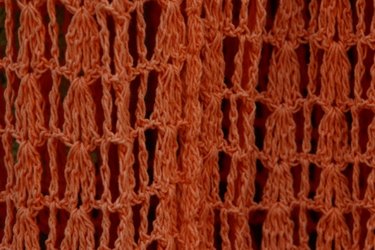
Raschel knitting, a type of warp knitting, produces an openwork fabric resembling crochet. Bulkier and less elastic than some other types of warp knitting, Raschel knit fabric is often used in outerwear. Raschel knitting machines produce a wide selection of fabrics ranging from mesh bags and net fabrics such as mosquito netting, chemical fiber garments and technical and medical net textiles to lace curtains and edgings, veils, narrow tapes and blankets. Raschel knitting is an industrial knitting process and is not done by hand.
Warp Knitting
Video of the Day
Knitted fabric falls into two categories: weft knit and warp knit fabric. Warp knit fabric consists of a series of wales, or parallel ridges, running lengthwise through the material. Warp knitting machines contain beds of latch needles; each loops its own thread in the knitting process, creating rows of stitches linked in a zigzag pattern. The fabric is knitted vertically instead of in the usual horizontal rows, and a separate strand of yarn is required for every column of stitches. The front of the fabric contains angled vertical stitches, while the back consists of horizontal floats called laps or underlaps. Raschel knitting and tricot knitting are the two most common types of warp knitting.
Video of the Day
Raschel Knit Fabric Characteristics
Raschel knitting machines produce both flat and tubular warp knit fabrics that resemble crochet and lace fabrics. Raschel knit material can contain inlaid yarns in addition to the vertical rows of stitches. The fabrics are similar to tricot knitting but more open and with a coarser texture. Warp knit fabrics have greater dimensional stability than weft knit materials and are less likely to sag, nor do they ravel as easily.
Types of Raschel Knit Fabrics
Raschel warp knit machines generate fabrics in more diverse textures and designs than tricot warp knit machines. Some materials are single-faced; others are reversible. Raschel knitting machines use a wide variety of yarns, ranging from smooth, tightly-spun yarns to novelty yarns. The resultant fabrics vary greatly from lightweight lace to heavy chenille, from fancy embroidery to coarse texture. They tend to have little stretch and hold their shapes well.
Using Raschel Knit Fabrics
When machine sewing Raschel knit fabric, use a roller foot; stop and raise the foot periodically to allow the fabric to resettle itself. Use a stitch length of eight to ten stitches per inch. Sew seams with overlock stitching, and reinforce them to prevent stretching. Avoid making buttonholes if possible.